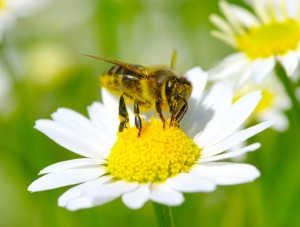Combat the Decline in Pollinators by Identifying Flowers Bees Love
 As you enjoy the bursts of color in your summer garden, are you already planning the changes you’ll make in your garden design next year? One important change to consider is creating a haven for bees by identifying flowers that benefit pollinators.
As you enjoy the bursts of color in your summer garden, are you already planning the changes you’ll make in your garden design next year? One important change to consider is creating a haven for bees by identifying flowers that benefit pollinators.
Gardeners across the U.S. are adjusting their garden designs to help rebuild the declining bee population. By identifying flowers that feed bees, you can join in the movement and save not only the bees but also the flowers and fruits that need pollination.
A great place to start your bee-friendly garden design is with a list of the flowers that give bees the source of nectar and pollen they need:
Bee-Friendly Flowers
- Alyssum
- Agastache (Anise hyssop)
- Asclepias (Butterfly weed)
- Aster
- Berbris (Oregon grape)
- Ceanothus (Wild-lilac)
- Chrysothamnus (Rabbit-brush)
- Echinacea (Coneflower)
- Eriogonum (Wild buckwheat)
- Eupatorium (Joe-pye weed)
- Geranium
- Helianthus (Sunflower)
- Kallstroemia (Caltrop)
- Larrea (Creosote bush)
- Lupinus (Lupine)
- Monarda (Bee balm)
- Papaver (Poppies)
- Penstemon
- Phacelia (Scorpion-weed)
- Rhododendron
- Ribes (Currant)
- Rudbeckia (Black-eyed Susan)
- Salix (Willow)
- Salvia (Sage)
- Sambucus (Elder)
- Solidago (Goldenrod)
- Symphoricarpos (Snowberry)
- Trifolium (Clover)
- Vaccinium (Huckleberry)
- Wildflowers
Creating Your Bee-Friendly Garden Design
Wildflowers or flowers that are native to your area are a great plant choice for encouraging pollinators because of their hardiness. Hardier flowers are easier to care for and will thrive even when weather takes its toll on more delicate garden flowers.
When identifying flowers you want to include in your bee habitat, remember that bees differ in preferences just as we humans prefer different meals and abodes. A broad selection of flower shapes and sizes gives bees of every variety a place to call home.
Blooming season is another factor to consider in flower choice. Because pollinator varieties operate on different activity schedules, it’s important to plant flowers that will bloom at different times of the year. With a well-planned garden design, you can help provide each bee variety the nourishment they need.
The Trouble With Pesticides
You wouldn’t want to plant a beautiful bee habitat only to have them endangered by toxic chemicals. Avoiding pesticides altogether in favor of nontoxic pest control techniques is the safest route. However, if you do choose to use a pesticide, try to select one that targets the specific pest you want to eradicate.
Reading the pesticide label thoroughly will give you the best understanding of where and how to use the product in the safest manner possible. Refrain from using pesticides near open blossoms or any areas you have seen pollinators frequent.
Identifying Flowers in Your Garden Design That Are Bee-Friendly
You may decide to incorporate a mix of flowers that attract bees in your current garden design. In this case, identifying flowers for pollinators with stainless steel plant markers can help you remember which plants are critical for your bee habitat. You’ll love the longevity and flexibility you gain with Kincaid Plant Markers. Place your order for markers and labels today!
